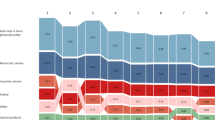Abstract
Purpose
Literature showed that age could play an inverse effect on weight reduction and higher values of weight loss were associated with higher levels of body mass index (BMI). Based on this evidence, an 8-week Zumba study examined possible relationships that could exist among the variables of weight loss and age, and weight loss and BMI in 36 females, mean age 34.25 ± 8.50 years and mean BMI 32.98 ± 5.32 kg/m2.
Methods
The intervention involved 16 hourly Zumba sessions held twice weekly over 8 weeks. The exercises comprised a mixture of merengue, salsa, reggaeton and bachata with warm-up and cool-down activities. They were of low-impact style but were maintained at vigorous intensity that was still bearable for the obese subjects. Weight and height were recorded before and after the programme with a Seca 807 scale and a Seca 213 stadiometer. The age of last birthday was also taken.
Results
Spearman’s correlations showed a very strong negative and statistically significant association between the participants’ mean weight loss and their respective age groups: ρ = −0.83, P = 0.04, and a very strong positive but statistically insignificant association between their mean weight loss and respective BMI categories: ρ = 0.80, P = 0.20.
Conclusion
Between-subjects variations, including the investigated variables of age and BMI, acted as confounders in the interpretation of the correlation results. Despite these extraneous factors, this was the first study that investigated how weight loss during a Zumba programme for women could vary separately with age and BMI.

Similar content being viewed by others
Notes
Precautions such as calibration of scales and duplicate height measurements served to minimize the chances of instrumentation threat and measurement errors.
Instead of going for the non-parametric version of the Pearson’s correlation, the investigator could have opted to transform the data using mathematical functions but preferred to coax them into more meaningful variables by converting them into rank-ordered categories.
References
Micallef C (2014) The effectiveness of an 8-week Zumba programme for weight reduction in a group of Maltese overweight and obese women. Sport Sci Health 10:211–217. doi:10.1007/s11332-014-0195-8
Williamson DF, Serdula MK, Anda RF, Levy A, Byers T (1992) Weight loss attempts in adults: goals, duration, and rate of weight loss. Am J Public Health 82:1251–1257. doi:10.2105/AJPH.82.9.1251
St-Onge M-P, Gallagher D (2010) Body composition changes with aging: the cause or the result of alterations in metabolic rate and macronutrient oxidation? Nutrition 26:152–155. doi:10.1016/j.nut.2009.07.004
Hill RJ, Davies PSW (2001) The validity of self-reported energy intake as determined using the doubly labelled water technique. Br J Nutr 85:415–430. doi:10.1079/BJN2000281
Waluga M (1990) Effect of physical exercise and heat on energy expenditure in obesity. Pol Arch Med Wewn 83:120–126
Prentice AM, Black AE, Coward WA, Cole TJ (1996) Energy expenditure in overweight and obese adults in affluent societies: an analysis of 319 doubly-labelled water measurements. Eur J Clin Nutr 50:93–97
U.S. Department of Health and Human Services (2008) 2008 physical activity guidelines for Americans. U.S. Department of Health and Human Services, Washington
Crawford S, Eklund RC (1994) Social physique anxiety, reasons for exercise and attitudes toward exercise settings. J Sport Exerc Psychol 16:70–82
U.S. Department of Health and Human Services (1996) Physical activity and health: a report of the surgeon general. U.S. Department of Health and Human Services, Atlanta
Scherer S (2009) Addressing cardiovascular risk as part of physical therapist practice. What about practice recommendations for physical therapists? Cardiopulm Phys Ther J 20:27–29
Swinscow TDV, Campbell MJ (2002) Statistics at square one, 10th edn. BMJ Publications, London
Ali AT, Crowther NJ (2009) Factors predisposing to obesity: a review of the literature. JEMDSA 14:81–84
Tabachnick BG, Fidell LS (2007) Using multivariate statistics, 5th edn. Pearson Education, Boston
Acknowledgments
The author thanks Mrs June Sampson and Prof Antony Stewart from Staffordshire University for their support. Further acknowledgements go to the Malta Sports Council (KMS) and the Ministry of Health for allowing the author sufficient time to do the necessary research and preparations for this study. The permission from the KMS and the University of Malta to use their hall for the Zumba sessions is also appreciated. Gratitude is extended to the Zumba instructress, Ms Johanna Refalo, and to Mr William Galea, a KMS Executive Officer. This paper was not supported by any funding body.
Conflict of interest
There was no conflict of interest to declare.
Author information
Authors and Affiliations
Corresponding author
Rights and permissions
About this article
Cite this article
Micallef, C. Associations of weight loss in relation to age and body mass index in a group of Maltese overweight and obese women during an 8-week Zumba programme. Sport Sci Health 11, 97–102 (2015). https://doi.org/10.1007/s11332-014-0211-z
Received:
Accepted:
Published:
Issue Date:
DOI: https://doi.org/10.1007/s11332-014-0211-z




